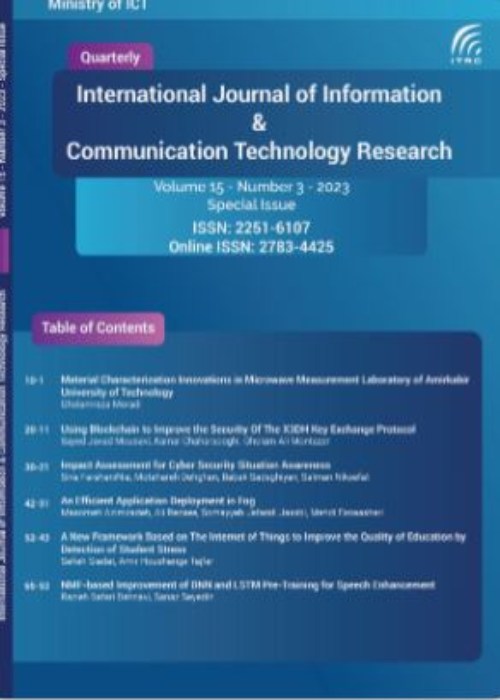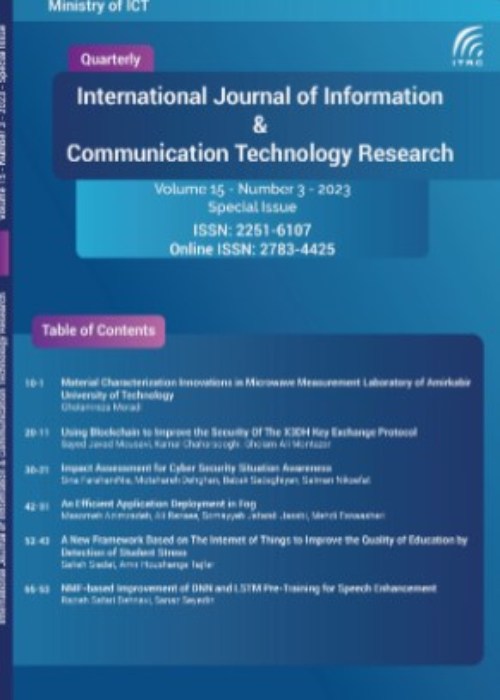فهرست مطالب

International Journal Information and Communication Technology Research
Volume:15 Issue: 3, Summer 2023
- تاریخ انتشار: 1402/07/03
- تعداد عناوین: 6
-
-
Pages 1-10
This paper presents some microwave circuits, designed for characterization of materials’ permittivity. These include single and multiple-resonant types, transmission line approaches, radiation structures and planar circuits. They have either theoretical analysis, simulations, behavior analysis, or fabrication results. A simple half-wavelength coaxial system is used for measuring velocity factor or dielectric constant of the cable. This method presents very accurate results. A planar multi-dielectric antenna structure is proposed whose layers comprise the dielectric under test. The near field as well as the radiation performances are influenced by the permittivity, which is the basis for determining this parameter. Also, a planar resonant cavity is designed and optimized to give enhanced coupling performance and gets higher quality factors. It has a small size and its sensitivity is improved employing a chamfer. The values of dielectric constants are extracted from scattering parameters. In another method, a three-section microstrip line is used whose time domain response is employed to retrieve the dielectric constant. This method can be generalized to other planar lines. At last, a simple method for measuring complex conductivity of lossy planar conductors is studied and it is employed for characterization of a graphene oxide layer.
Keywords: Cable Characteristics, Complex Permittivity, Dielectric Constant, Microwave Measurement, Printed Circuit Measurement, Substrate Integrated Waveguide, Time Domain Reflectometry -
Pages 11-20
First and most important step to making secure end-to-end encryption is key exchange. X3DH is one of the most used protocols to do that. It uses a trusted server to exchange keys. If the key exchange is secure then we have identification, authentication, integrity, non-repudiation, and confidentiality for messages. In X3DH, if the trusted server is compromised the entire end-to-end encrypted connection will be exposed. Transport Layer Security (TLS) is used for client-server communication. Therefore, the whole security is based on a certificate authority (CA) therefore there will be the single point of failure. In this paper, we proposed using blockchain as a trusted medium to exchange keys and identity authentication. The proposed method is based on the use of X3DH in instant messaging. This method improves the first step of the X3DH algorithm which includes authentication. This is the first time using blockchain directly to identify a user.
Keywords: End-to-end encryption, X3DH, Asymmetric encryption, Blockchain, Identity key, Authentication -
Pages 21-30
Cyber security situation awareness is important for the analysis of cyberspace, and detection of ever-changing threats. As computer networks and systems continue to increase in complexity and sophistication, the requirements and on a cybersecurity operator increase as well. In this paper, we propose a simulation system to assess the impacts of attacks on cyber assets and identify critical assets. Our proposed system helps to have better situation awareness. For this purpose, we first generate the business process model of the organization. This business process model not only contains information about the mission activities but also contains features of the process itself and the context in which the system operates. Then, we determine the dependency between the processes and the cyber assets of an enterprise. Finally, we simulate some attacks on cyber assets. We evaluate the impacts of attacks on the cyber assets and asset-dependent processes by comparing the Measure of Effectiveness before and after of attack simulation.
Keywords: Cyber Security, Situation Awareness, Business Process Model, Simulation, Cyber Attack, Measure of Effectiveness, Impcat Assessment -
Pages 31-42
Fog computing emerged to meet to the needs of modern IoT applications, such as low latency, high security, etc. To this end, it brings the network resources closer to the end user. The properties of fog computing, such as heterogeneity, distribution, and resource limitations, have challenged application deployment in this environment. Smart service placement means deploying services of the IoT applications on fog nodes in a way that their service quality requirements are met and fog resources are used effectively. This paper proposes an efficient application deployment method in fog computing using communities. In contrast to previous research, the proposed method uses more factors than topological features to distribute network capacity more evenly between communities. This results in efficient use of network resources and better fulfillment of application requirements. In addition, according to our argument, using multiple criteria to prioritize applications will lead to better deployment and more effective use of resources. For this purpose, we use the number of application requests besides the deadline factor for application prioritization. Extensive simulation results showed that the proposed method significantly outperforms the state-of-the-art methods in terms of meeting deadlines, decreasing delays, increasing resource utilization, and availability by about 17, 33, 7, and 11 percent, respectively.
Keywords: Fog Computing, Application Deployment, Evolutionary Computation -
Pages 43-52
The Internet of Things (IoT) is one of the new technologies that has received significant attention in the last decade and has been used in all aspects of life (including agriculture, medicine, business, industry, education, etc.).
One of the most important applications of the Internet of Things is in the process of student education, which has been discussed a lot in recent years and has led to a significant progress in the education industry, however, there are still many challenges in this field, which includes managing classrooms, conference halls, teaching in offices, public schools, and e-learning websites. Therefore, it is necessary to create a new framework to improve teaching methods. On the other hand, providing educational materials for students according to their level of understanding and learning goals can have a significant effect on improving the quality of teaching and learning.
In this research, a framework for improving the quality of teaching to students in the context of the Internet of Things has been presented. In this framework, the mental and psychological condition and stress conditions of the students are investigated and provided to the teacher in real-time, so that they can make the right decision with sufficient information based on the conditions of each student in the classroom and use the information to adapt their teaching methods and tests. This framework, with the help of the Internet of Things, provides information about each student and mental and psychological elements (such as heart rate, body temperature, etc.) as well as factors affecting the classroom environment (including the amount of noise pollution, ambient temperature, light, etc.), collects and uses fuzzy logic to place students in different categories with and without stress conditions. Kuja simulator and MATLAB software are used for simulation. The results of the simulation show that this framework can detect the students' stress and by adapting the test and teaching conditions to the mental and psychological state of the students, it can indirectly improve the educational quality for students.Keywords: Internet of Things (IoT), e-learning, Stress, psychological elements, environmental influencing factors.rs -
Pages 53-65
A novel pre-training method is proposed to improve deep-neural-networks (DNN) and long-short-term-memory (LSTM) performance, and reduce the local minimum problem for speech enhancement. We propose initializing the last layer weights of DNN and LSTM by Non-Negative-Matrix-Factorization (NMF) basis transposed values instead of random weights. Due to its ability to extract speech features even in presence of non-stationary noises, NMF is faster and more successful than previous pre-training methods for network convergence. Using NMF basis matrix in the first layer along with another pre-training method is also proposed. To achieve better results, we further propose training individual models for each noise type based on a noise classification strategy. The evaluation of the proposed method on TIMIT data shows that it outperforms the baselines significantly in terms of perceptual-evaluation-of-speech-quality (PESQ) and other objective measures. Our method outperforms the baselines in terms of PESQ up to 0.17, with an improvement percentage of 3.4%.
Keywords: pre-training, deep neural networks (DNN), long short-term memory (LSTM), non-negative matrix factorization (NMF), speech enhancement, basis matrix, noise classification


